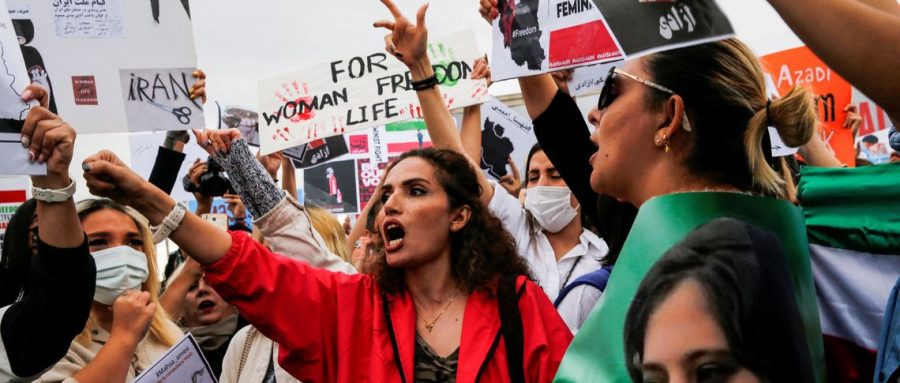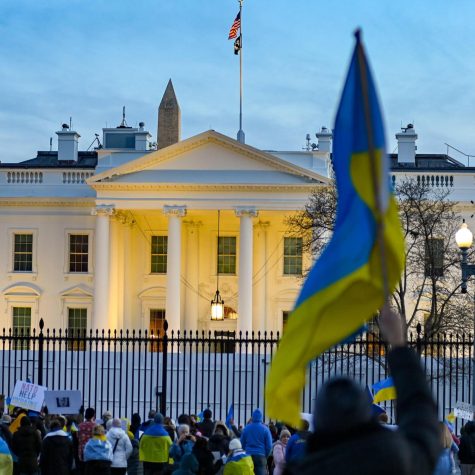The Current State Of Protest In Iran
November 28, 2022
It is time to take a stand. As battles for gender equality and fights against repressive governments/policies are being waged in the USA and the entire globe, now is a time for unrest and time for people to take a stand. Countries of concern include but are not limited to the Pro-Choice protests in the USA, fighting against repressive forces of of Russia in Ukraine, and most recently the uproar in Iran due to the repressive government policies towards women.
On September 13th, 2022, Mahsa Amini was arrested and taken into custody by Iran’s morality police at a metro station in Tehran, Iran. Officials have claimed the reports from witnesses of beating and other injustice upon arrest are false. Amini was arrested after stepping out of a train station during a visit with family to see her uncle in the Capital. They arrested the 22 year old for not wearing her hijab correctly and wearing tight trousers. She was taken to a detention center where it was reported she was beaten. Her brother waited for her outside. Two hours later, an ambulance arrived to transport Amini to the hospital in Tehran, Iran, because she collapsed of a heart attack, and officials claim she died on September 16, three days after falling into a coma. The coroner report claims her death was caused by “multiple organ failure caused by cerebral hypoxia” linking to pre-existing medical conditions, and not the several blows to the head reported from the arrest. However, her family discredited this claiming she had no pre-existing heart conditions. Her father Amjad Amini, told BBC Persia, “I have no idea what they did to her, everything is a lie.”
Amini graduated from Taleghani Girls’ High School in 2018, at her time of death she had just been admitted to university and aspired to be a lawyer. She has a little brother, her father works for the government, and her mom is a housewife. She was born on September 20th, 2000, she was four days away from turning 23. According to sources close to the family she was a shy, reserved resident of a small town who never challenged the country’s clerical rulers or its Islamic dress code. She lived in her hometown, the northwestern Kurdish city of Saqez, with her family. Masha Amini was her official given Persian name, but her birth name and what those close called her was Jina. She was buried in her hometown.
Since her death a movement had erupted not only in Iran but all over the globe in support of her and those like her to fight back against Iran’s repressive government. The movement has taken on the phrase “زن زندگی آزادی or Women, Life, Freedom”. Many Arab women across the world have taken off their Hijabs in solidarity. Over 15,000 protesters have been arrested in Iran already. The Media has swarmed the movement, with all major papers reporting on it for the past three months. Over 300 deaths have been reported, with around 50 being children.
People had also gathered outside the hospital where she died and many were arrested. Protesters have also been reported to have set fire to the former Supreme Leader’s ancestral home. The home serves as a museum open to the public honoring the man who founded the Iranian Republic. The semi-official Tasnim news agency denied Khomeini’s house was set on fire, and dates of videos could not be verified.
Two weeks ago, Iran’s parliament voted on the death sentence for the protesters arrested so far. 227 members of Iran’s 290-seat Parliament voted for death sentences for all arrested individuals with a signed open letter to the judiciary, as reported by Iran’s state-run news agency IRNA. In the statement, parliament members voted to support severe punishment of those who incited riots and called them “mohareb.” In Islamic or Sharia law, “mohareb” means “Enemy of God” and is associated with the death penalty.
Six have been sentenced so far, 2 killed, and 21 more are awaiting trial, and could be facing death by hanging. The status of the other prisoners is uncertain at this time. Reports surfaced that the government would sentence all arrested individuals to death. These reports have been said to be false and created by social media sites worldwide. Iran is ranked the second highest country for average executions in the world, following China. The age for girls to be able to be sentenced is as young as 9, but for boys is 15.
The Iranian government has a history of shutting off the internet to attempt to suppress/limit protesting against the regime, including one in 2019 that led to extreme civilian carnage. The government has shut off the internet again, although not to as extreme lengths. It has been confirmed that the civilians have also had trouble reaching some apps, including Whatsapp and Instagram. Doug Madory, the director-at Kentik, Inc., a network intelligence company-of internet analysis was quoted in an BBC article, “I don’t think there’s anything that would make us think that this is accidental. My understanding given the context is the objective was to stop people from sharing videos and communicating with the outside world.”
Most recently, the government has arrested two Iranian actresses Hengameh Ghaziani and Katayoun Riahi. Ghaziani was arrested for removing her headscarf on her social media account, while Riahi had in September given an interview without wearing a hijab. The two were arrested Sunday along with other popular figures who have voiced their support to the movement.
The Iran government has arrested the two Iranian journalists who helped break the story to the public, Niloofar Hamedi and Elahe Mohammadi. They have been held in Tehran’s Evin prison complex since late September. Also arrested was Hossein Ronaghi, a prominent blogger and activist who went on a hunger strike to protest his arrest, he has since been moved to the hospital due to a report of injuries sustained while in jail.
Prominent Iran rapper, Toomaj Salehi, has been arrested due to a claim his music encouraged rebellion. Ehsan Hajsafi, is the captain of Iran’s national football team, at the World Cup in Qatar he said that “we have to accept that the conditions in our country are not right and our people are not happy”. Also, Hossein Soori, the head of Iran’s boxing federation, spoke about that he would not be returning home from a Spain tournament because of the violent suppression of the protests. Iran’s leaders claim the protests are “riots” manipulated by foreign enemies.
President Biden has voiced his support of the protests and says he stands with the women of Iran. The UN human rights council has urged the removal of protesters but has gone unanswered. Iran joined the UN in 1945, as one of the 50 founding members. The United States is currently working to remove Iran from the UN Commission on the Status of Women as announced by VP Kamala Harris earlier this month. “The United States believes that no nation that systematically abuses the rights of women and girls should play a role in any international or United Nations body charged with protecting these very same rights,” Harris said in a statement. This move includes vocal support from former first ladies Michelle Obama and Laura Bush and former Secretary of State Hillary Clinton.
Iran is a country in the Middle East, with roots of restrictive laws around their citizens, especially their women. Like many governments, they have laws regarding how women should be dressed. These laws are upheld and have proven to be extreme. Specifically, Hijab requirement laws have existed since 1981, two years after the Iranian Revolution.











